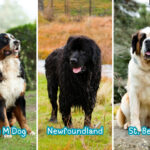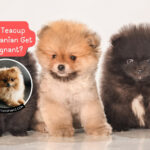 7 Nov
7 Nov11 Cool Facts About Beagles You Need to Know
These friendly canines have trotted their way into the hearts of dog lovers everywhere. If you’re drawn to their expressive eyes and merry demeanor, you’re not alone. But there’s more to these pups than meets the eye. As a seasoned dog parent with a soft spot for these lovable hounds, I’m excited to share some cool facts about beagles that may surprise you.
Beagles are not just another popular dog breed; they’re a unique blend of companionship, intelligence, and history wrapped up in a compact, adventure-ready package.
Whether you’re a proud beagle owner or considering adding one to your family, understanding these distinct traits is key to appreciating the full spectrum of their character. So, let’s get to know these fascinating dogs beyond the basics—here are 11 cool facts about beagles that you need to know. Get ready for some tail-wagging revelations!

Fact #1. Historical Hounds: The Ancient Origins of Beagles
Beagles hold a special place in the canine lineage, with roots reaching back to ancient times. This breed has a storied past that dates to before the Roman Empire when hounds similar to beagles were used for hunting. These early ancestors were prized for their tracking skills, primarily used for hunting small game due to their keen sense of smell and determination.
Fast forward to the 11th century, the beagle we recognize today began to take form in England. With the rise of fox hunting, the demand for dogs with exceptional tracking abilities surged. The beagle, with its remarkable nose and single-minded pursuit of scent, emerged as a breed tailor-made for the task.
But it wasn’t just their hunting prowess that made beagles a historical fixture. Their compact size allowed them to be foot-followed by hunters on foot, often those who could not afford to maintain a horse for riding to hounds. This quality endeared them to many who sought a sociable and active companion.
Interestingly, several strains of the breed emerged, each refined for specific types of hunting. For example, the larger Fox Beagle and the smaller Glove Beagle, so named for being small enough to fit on a glove, were once common variations.
It’s from these varied strains that the modern beagle, standardized in the 19th century, was born. This was when the breed began to be documented and the standard that defined the breed’s physical characteristics was established.
The beagle’s ancestors were meticulously bred to enhance traits that hunters most valued: a sharp nose, a robust build, and an amiable nature. This dedication to breeding not only perfected the beagle as a hunting companion but also as the friendly and curious family pet we adore today. This deep history showcases the beagle not just as a mere pet, but as a breed rich in legacy and tradition.
Fact #2. A Nose for Trouble: Beagles’ Exceptional Sense of Smell
Beagles have an extraordinary olfactory system, perhaps one of the most impressive among canines. Their sense of smell is so nuanced that it’s rivaled by only a few other breeds, such as the Bloodhound. This superpower comes from their astonishing 220 million scent receptors, compared to a human’s mere 5 million. This sensory richness enables them to pick up and differentiate a multitude of scents, a skill that has been harnessed in various roles beyond the hunting field.
The beagle’s nose is a biological marvel. It’s not just the quantity of scent receptors that sets them apart, but also their ability to discriminate between scents and remember them for future tracking. Their noses are so adept that they can identify and follow a scent trail that is days old, which makes them invaluable in roles that require tracking over long distances or time periods.
Their smelling prowess has found beagles many jobs in modern society. One notable role is with law enforcement and border security agencies, where they are employed as detection dogs.
These beagles are trained to sniff out contraband items such as illegal drugs and agricultural products that could bring harmful pests or diseases into a country. Airports might be where a beagle’s nose is most recognizable, often seen working with handlers moving among the luggage, using their scent-trailing capabilities in real-time.
In the medical field, the beagle’s nose has taken on a groundbreaking job: disease detection. With training, beagles have been able to detect specific cancer types by smelling breath, blood, or urine samples, offering a non-invasive diagnostic option. Their involvement in medical research continues to grow as we learn more about their ability to detect the volatile organic compounds associated with various illnesses.
Furthermore, conservation efforts have also benefited from the beagle’s nose. They are utilized to locate endangered animal species by tracking their scents or to sniff out invasive plant species that threaten ecosystems.
The beagle’s sense of smell transcends the role of a household pet. It’s a tool that has been harnessed to protect and serve communities in diverse and impactful ways. This facet of their natural history not only highlights their service to humanity but also underscores the remarkable capabilities locked within the genetics of this affable breed.

Fact #3. The Vocal Virtuosos: Understanding Beagle Barks and Bays
Beagles are a vocal breed, known for their distinctive array of sounds that go well beyond the typical bark. This breed communicates through a diverse vocabulary of howls, bays, barks, and whines, each with its own meaning and purpose. Their baying—a loud, long-drawn-out sound that carries over distances—was historically a signal to hunters that prey was afoot. In a household setting, these sounds can signify anything from excitement to alerting their family of perceived strangers.
Understanding a beagle’s vocalizations is key to a harmonious relationship. A beagle might howl in response to sirens or other dogs in the distance as a form of “singing along” or asserting their presence. Their barking could be a call for attention or play while whining is often associated with a desire for comfort or companionship.
Managing a beagle’s vocal habits requires patience and training. Positive reinforcement can encourage quiet behavior while providing plenty of physical and mental stimulation to help minimize excessive vocalization borne out of boredom or excess energy. Teaching a “quiet” command is a useful strategy, rewarding the beagle when they cease barking upon request.
Training aside, it’s essential to listen to what a beagle’s vocal patterns might be indicating. Consistent or anxious sounds could point to underlying needs or discomforts that may require attention. By tuning into their distinctive forms of expression and responding appropriately, owners can foster a better understanding and a stronger bond with their beagle companions.
Fact #4. Petite Powerhouses: Beagle Size and Physique
Beagles are the epitome of the phrase “small but mighty.” With a robust and muscular build, they stand between 13 to 15 inches at the shoulder and generally weigh between 20 to 30 pounds. This puts them squarely in the small to medium-sized category of dog breeds. Despite their compact size, they pack a lot of muscle and bone, giving them the sturdiness needed for their original purpose as scent hounds.
The beagle’s size is an asset that makes them incredibly versatile. They are large enough to engage in a variety of outdoor activities, from hiking to playing fetch, yet small enough to be comfortably accommodated in apartments or smaller homes. This adaptability extends to city living or sprawling country estates alike, making them an ideal choice for a broad spectrum of dog lovers.
Their stature is also beneficial for families with children, as beagles are sturdy enough to handle playtime but not so large as to be overwhelming. For those who travel, beagles are also a convenient size for transport, fitting comfortably into car seats and under airplane seats as necessary.
The physique of a beagle is designed for endurance. They possess a deep chest that houses strong lungs, essential for long periods of activity. Their compactness contributes to their agility, allowing them to navigate through various terrains with ease — a trait that made them excellent hunting companions and now translates to adventurous family pets.
Fact #5. The Many Colors of Companionship: Beagle Coat Variations
The beagle is a breed that sports a delightful variety of coat colors and patterns, each adding to their individual charm. The American Kennel Club recognizes up to 11 standard coat colors and 25 markings for beagles. Some of the most common color combinations include tricolor (black, brown, and white), red and white, and lemon and white. However, you might also see beagles with blue ticks, chocolate tri, or even rarer hues like lilac.
No matter the color, the beagle’s coat is typically short, dense, and weather-resistant, fitting for a breed that spends a great deal of time outdoors. Their coats are also a marker of their genetic diversity and have no bearing on their personality or temperament.
From a breed standard perspective, while color and pattern can be important for show dogs, with certain patterns and colors being more desirable in the ring, the variety doesn’t impact a beagle’s qualification as a great companion. It’s essential for potential beagle owners to understand that a beagle’s color or pattern should not be the sole determinant of their choice; the breed’s overall health and temperament should take precedence.
Regarding health, there’s no scientific evidence to suggest that a beagle’s coat color directly impacts their general well-being. However, it’s worth noting that certain color patterns can be associated with rare genetic conditions. For instance, the gene that produces the beautiful merle pattern can be linked to deafness and blindness if not bred responsibly.
Fact #6. Energy to Spare: The Beagle’s Exercise Needs
Beagles are bundles of energy, bred for stamina and persistence in the field. This translates to a need for regular, vigorous exercise to maintain their mental and physical health. An adult beagle typically requires at least an hour of exercise each day, which can be split between walks, play sessions, and other activities.
Their exercise regime should cater to both their physical and scenting prowess. Activities like long walks in new environments, hikes through nature, and playdates with other dogs can help expend physical energy, while scent trails and interactive games like hide-and-seek with treats can engage their powerful noses.
For beagle owners, it’s beneficial to have a secure, fenced area where these curious hounds can explore off-leash safely. Beagles are known for following their noses, which can sometimes lead them astray. Ensuring they have a safe space to run and play can prevent any unplanned adventures.
In terms of specific activities, consider scent work or tracking sports that play to the beagle’s natural instincts. Agility training can also be a great way to burn energy and provide mental stimulation. However, it’s essential to remember that every beagle is an individual, and their exercise needs may vary. Some may require more physical play, while others may be content with a bit more sniffing time.
Regular exercise helps mitigate potential behavioral issues like digging, excessive barking, or chewing, which can arise from boredom or pent-up energy. By keeping your beagle active and engaged, you’ll not only fulfill their exercise needs but also deepen the bond you share with your energetic companion.

Fact #7. Celebrity Status: Beagles in Pop Culture
Beagles have had more than their fair share of the spotlight in popular culture, often portrayed as lovable and tenacious characters. The most iconic of these is undoubtedly Snoopy from Charles M. Schulz’s “Peanuts” comic strip. Snoopy, with his imaginative and adventurous personality, has become a global symbol of the breed, endearing beagles to millions and solidifying their reputation as loyal and playful companions.
Another famous beagle, Uno, captured hearts as the first beagle to win Best in Show at the Westminster Kennel Club Dog Show in 2008. Uno became a canine ambassador, making appearances on television shows and at charity events, further promoting the breed’s affable nature and increasing their popularity.
On the big screen, films like “Shiloh” showcase beagles’ loyalty and emotional depth, while “Cats & Dogs” displays their comical and clever side. In literature, “Underdog” is a beagle superhero with a mild-mannered secret identity, representing the underdog in us all and highlighting the breed’s brave and protective traits.
These representations have greatly influenced public perception by highlighting the breed’s positive attributes — intelligence, curiosity, and a friendly demeanor. They’ve also played a role in establishing beagles as family-friendly pets, well-suited for a variety of roles, from companion to cultural icon.
However, it’s important to note that while these portrayals have certainly increased the breed’s popularity, they can sometimes lead to a misconception that beagles are low-maintenance pets. Prospective owners might expect a Snoopy but find themselves with a spirited dog that requires commitment and understanding. Thus, while beagles’ celebrity status has brought them love and admiration, it comes with the responsibility of educating potential owners about the realities of beagle care and behavior.
Fact #8. Canine Einsteins: The Intelligence of Beagles
Beagles may not top the charts when it comes to the traditional measures of canine intelligence, but what they possess is a specialized intelligence that’s often underestimated. Renowned for their problem-solving skills, especially when it involves food or scent trails, beagles have a type of intelligence that is purpose-driven and aligned with their breeding as scent hounds.
This breed’s cleverness can sometimes be mistaken for stubbornness, as beagles tend to be single-minded when they’ve picked up an interesting scent or are on the hunt for a tasty treat. They’re also adept at figuring out how to get what they want, whether that’s escaping from a yard to explore or navigating to that hidden bag of dog food.
Engaging a beagle’s mind involves catering to their olfactory strengths. Scent work games, where they have to find hidden treats or toys, can provide excellent mental stimulation. Puzzle toys that challenge them to solve a problem to receive a reward are also beneficial for keeping their brains active.
Obedience training can also be a good way to mentally stimulate beagles. It gives them a task to focus on and can strengthen the owner-pet relationship. However, because beagles are often food-motivated, using treats as rewards can be particularly effective in training sessions.
Regular training routines, interactive play, and varied exercises can keep beagles mentally stimulated and prevent the development of problematic behaviors born from boredom. By understanding and harnessing their unique form of intelligence, owners can ensure their beagle companions are not only physically active but mentally satisfied as well.

Fact #9. Family Favorites: Beagles as Pets
Beagles are often celebrated as excellent family pets due to their friendly and gentle nature. They are known for their even temper and curious disposition, coupled with enduring patience and a playful spirit that makes them particularly well-suited for households with children. Their size and energy level offer a great balance for families — they’re sturdy enough to handle the exuberant play but not so large as to be overwhelming.
Stories abound of beagles forming strong, indelible bonds with their family members. Take, for example, the story of a beagle named Bailey, who would wait at the bus stop every afternoon without fail for the children to return from school, greeting them with an exuberant wagging tail and gentle nuzzles.
Another testament to their loyalty is found in the story of Molly, a beagle who consistently showed an uncanny ability to sense when her family members were feeling unwell, staying by their side until they felt better. These anecdotes underline not just loyalty but an intuitive sense of empathy that beagles seem to possess.
Their loyalty and affection are not reserved for humans alone; beagles typically get along well with other pets. They are sociable animals who thrive on companionship, whether that’s with humans or other dogs.
However, prospective beagle owners should be aware that their need for companionship means they don’t do well with being left alone for long periods. They can become destructive if they’re bored or lonely, which is why they are best suited to a home where they will have company most of the time.
Fact #10. Longevity and Legacy: Beagle Health and Lifespan
Beagles are generally known for their robust health and can enjoy a lifespan of 10 to 15 years with proper care. Their longevity is a testament to their breeding and lifestyle, but as with any breed, they are prone to certain health issues that prospective owners should be aware of.
Common health concerns include obesity, due to their love for food and their propensity to overeat if given the chance. They can also experience ear infections, given their long, floppy ears that can trap moisture and debris. Other conditions to be mindful of are hip dysplasia, hypothyroidism, and certain types of cancer.
To help ensure a beagle lives a long, healthy life, regular veterinary check-ups are crucial. A balanced diet, monitored closely for portion size, can prevent obesity and related health issues. Routine exercise will keep them fit and stave off weight gain. It’s also important to maintain regular ear cleanings to prevent infections.
Prospective owners can adopt several practices for maintaining the health of their beagle:
- Consistent Exercise: Daily walks and play sessions help keep beagles physically healthy and mentally stimulated.
- Proper Nutrition: High-quality dog food served in appropriate portions, along with limited treats, can help manage weight.
- Preventative Care: Regular vet visits, vaccinations, and parasite control are vital in catching and preventing health issues early on.
- Dental Hygiene: Regular teeth brushing or dental treats can help prevent periodontal diseases, which can be common.
- Mental Engagement: Beagles are intelligent and need mental stimulation to stay happy, which also contributes to overall health.
- By providing a loving home with proper care and attention to their unique needs, owners can contribute to their beagle’s quality of life, ensuring they remain a joyful companion for many years.
Fact #11. A Breed Apart: Unique Beagle Behaviors and Traits
Beagles are indeed a breed apart, blessed with a host of behaviors and traits that are as endearing as they are unique. One of the most charming beagle quirks is their famous “beagle bay.” This distinctive howl is music to the ears of some owners, reminiscent of the breed’s hunting dog ancestry.
Additionally, beagles are known for their exceptional curiosity. They will follow their noses wherever a scent may lead, often becoming completely absorbed in their olfactory exploration. This can sometimes result in the infamous “selective hearing” when a beagle is so focused on sniffing that it seems to ignore all calls and commands.
Their playfulness is another trait that owners cherish. Beagles often retain a puppy-like demeanor well into adulthood, bringing a sense of fun and mischief into their families’ lives. This can range from spontaneous play bouts to the gentle teasing of their human counterparts.
However, these behaviors require owners to take a specific approach to training and managing their beagle companions. The breed’s strong instinct to follow scents, for example, means they should be kept on a leash or in a secure area to prevent them from wandering off.
Positive reinforcement techniques work well during training, especially when using scent and food as rewards. And given their intelligence and energy, beagles benefit from interactive play and training sessions that challenge their minds and satisfy their need for activity.
Understanding and embracing these unique behaviors is crucial for any beagle owner. With patience, consistency, and a sense of humor, these traits can be shaped into a well-rounded and well-behaved pet. Owners are often rewarded with not just a loyal companion, but a four-legged family member with a personality that’s as rich and varied as the breed’s own history.




